Beneficial
none known
Family: Trogidae Subfamily: Troginae Genus: Omorgus Species: Omorgus suberosus (Fabricius, 1775)
none available
Total body length 11.1–14.1 mm (0.44–0.56 in). Body shape oval; surface rough and warty, often dirt encrusted. Venter flat, dorsum convex in lateral view. Color dark grey-brown. Pronotumpronotum:
the dorsal surface of the thorax
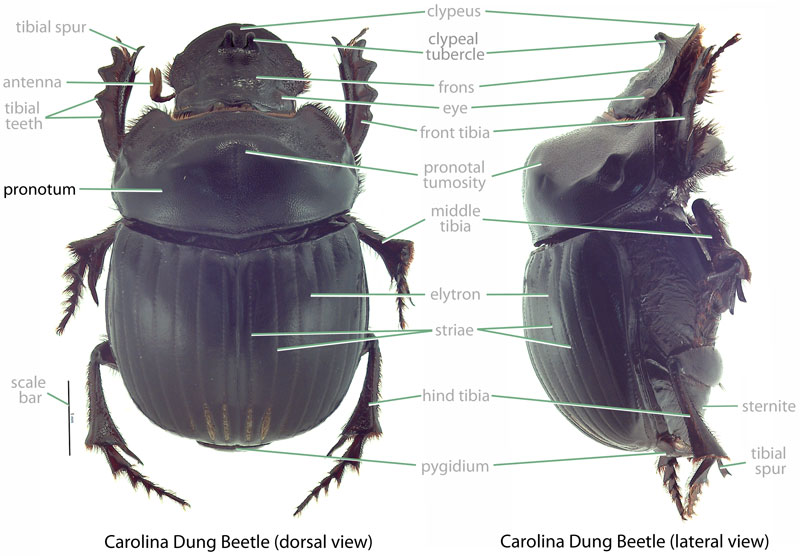 with base scalloped, basal anglebasal angle:
with base scalloped, basal anglebasal angle:
in reference to the pronotum, the basal and lateral corner
obtuse. Scutellumscutellum:
the triangular portion of the thorax between the bases of the elytra
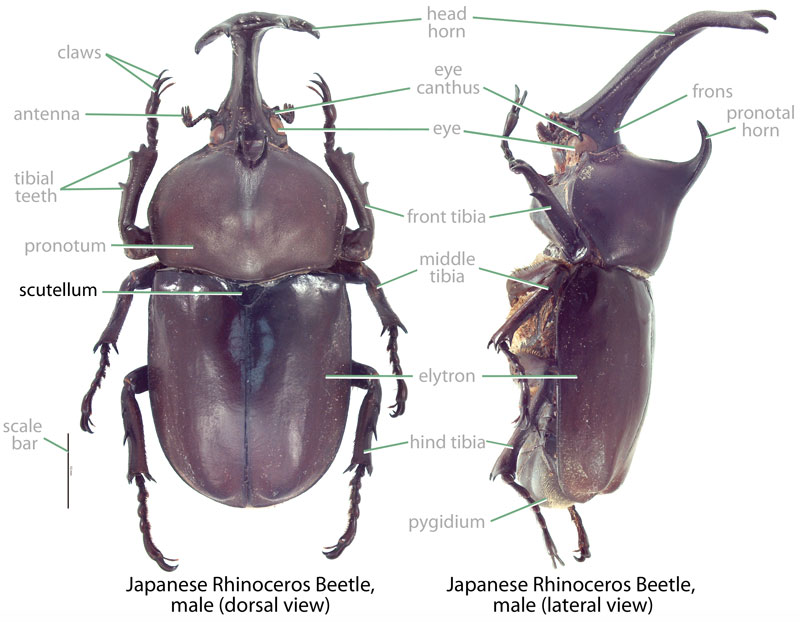 hastatehastate:
hastatehastate:
somewhat diamond-like in shape
, never rounded. ElytraElytra:
the hardened and chitinous wing-cover of a beetle that protect and overlie the flight wing
with dense patches of tomentosetomentose:
hairs or setae that are flattened, dense, and matted in appearance
greyish hairs. Middle tibiatibia:
a segment of the leg articulated with the tarsus and femur
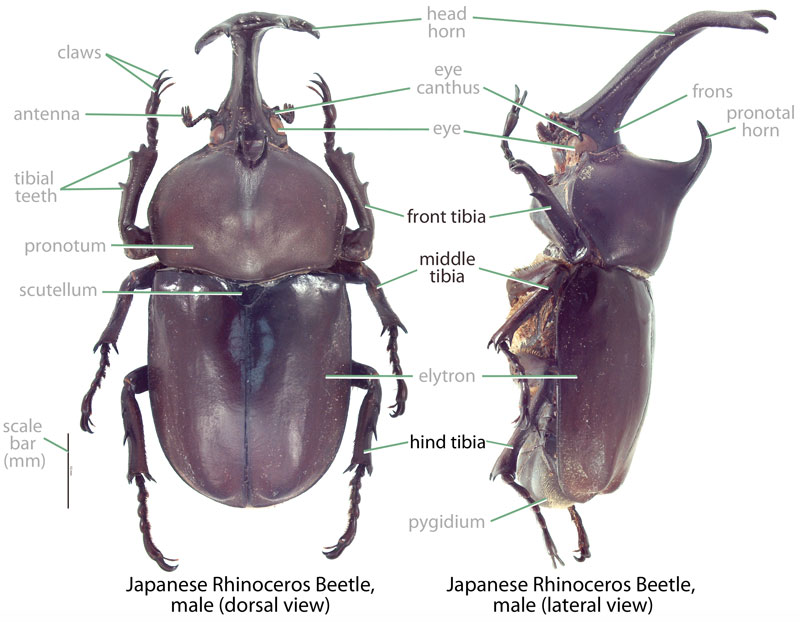 lacking numerous fine teeth along outer margin.
lacking numerous fine teeth along outer margin.
Undescribed. For Omorgus spp. (Ritcher, 1966Ritcher, 1966:
Ritcher P. 1966. White grubs and their allies: a study of North American scarabaeoid larvae. Oregon State University Monographs, Studies in Entomology 4: 1-219.): Grub C-shaped, not hump-backed, cylindrical, whitish. Maxillamaxilla:
set of paired mouthparts located posterior to the mandibles
with galeagalea:
outer branch or lobe of the maxilla
 and lacinialacinia:
and lacinialacinia:
inner portion of the maxilla distinctly separated. AntennaeAntennae:
distinctly separated. AntennaeAntennae:
paired sensory organ on head, formed from numerous segments
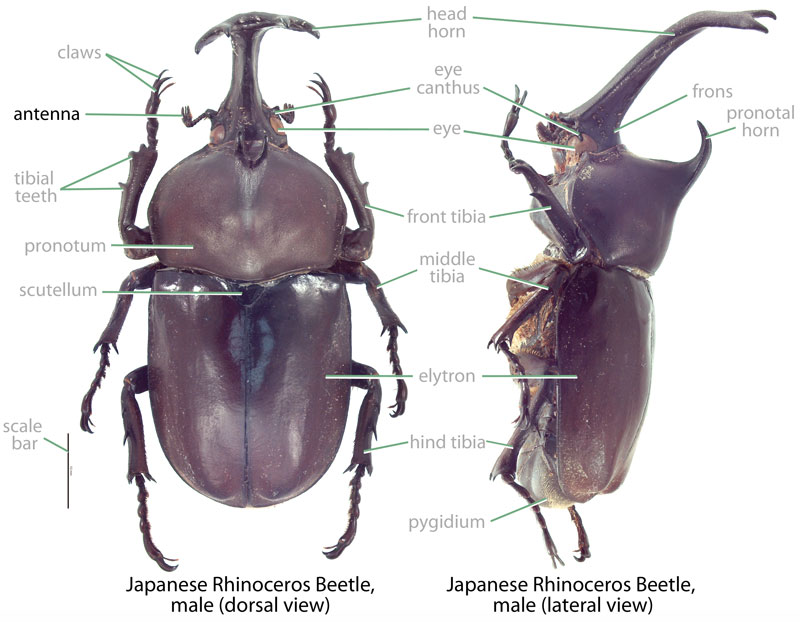 with 3 segments, lacking distaldistal:
with 3 segments, lacking distaldistal:
situated away from the point of articulation, thus usually furthest from the body
sensory cone on second segment. Distaldistal:
situated away from the point of articulation, thus usually furthest from the body
segment of antennaeantennae:
paired sensory organ on head, formed from numerous segments
 much reduced in size. Epipharynxepipharynx:
much reduced in size. Epipharynxepipharynx:
lobe on the interior surface of the labrum or clypeus
with tormaetormae:
in scarab larvae, sclerotized structures on the ends of the clypeolateral suture extending towards the mesal line
united mesallymesally:
at or near midline of body
. Legs 4-segmented, never with stridulatory organ. Spiraclesspiracles:
opening on the abdomen or thorax through which air enters and exits the body
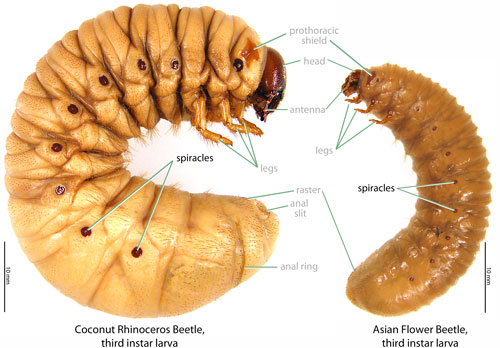 cribriformcribriform:
cribriformcribriform:
sieve-like in appearance
.
The Americas and Oceania. This species is found through much of the Americas, from Canada to South America. In the contiguous U.S., it is absent only from New England and the Pacific Northwest (Ratcliffe and Paulsen, 2008Ratcliffe and Paulsen, 2008:
Ratcliffe B and Paulsen P. 2008. The scarabaeoid beetles of Nebraska (Coleoptera: Scarabaeoidea). Bulletin of the University of Nebraska 22: 138-248.). It is also widespread throughout Australia and the Pacific Islands (Zidek, 2013Zidek, 2013:
Zidek J. 2013. Checklist and bibliography of the Trogidae (Coleoptera: Scarabaeoidea). Insecta Mundi 314: 1-38. full text (accessed 2015)).
None. Both adults and larvaelarvae:
the immature form of an insect; in scarabs, also called grub or white grub; preceded by the egg stage, followed by the pupal stage
 of this species feed on late stage carrion and other dry animal remains, thus posing no threat to crops or ornamental plants.
of this species feed on late stage carrion and other dry animal remains, thus posing no threat to crops or ornamental plants.
Poorly known. This species is known to feed on late stage carrion (Ratcliffe and Paulsen, 2008Ratcliffe and Paulsen, 2008:
Ratcliffe B and Paulsen P. 2008. The scarabaeoid beetles of Nebraska (Coleoptera: Scarabaeoidea). Bulletin of the University of Nebraska 22: 138-248.). In Hawaii, it has been found feeding on discarded chicken remains at poultry farms on Oahu (Toyama and Ikeda, 1976Toyama and Ikeda, 1976:
Toyama GM and Ikeda JK. 1976. An evaluation of fly predators at animal farms on leeward and central Oahu. Proceedings of the Hawaiian Entomological Society 22: 369-384.). In temperate areas, this species overwinters as an adult. Adults can be collected at lights at night and are likely nocturnal. In Nebraska, adults have been collected from April until October (Ratcliffe and Paulsen, 2008Ratcliffe and Paulsen, 2008:
Ratcliffe B and Paulsen P. 2008. The scarabaeoid beetles of Nebraska (Coleoptera: Scarabaeoidea). Bulletin of the University of Nebraska 22: 138-248.). Reports of this species feeding on grasshopper eggs (Schistocerca spp.) are likely erroneous (Hawaiian Entomological Society, 1977Hawaiian Entomological Society, 1977:
Anonymous. 1977 . Trox spp . in Hawaii. Proceedings of the Hawaiian Entomological Society 22: 397-398. full text (accessed 2015)).
Established. While it is not clear when this species first arrived to the state, the first specimen was found in 1970 on Oahu (Hawaiian Entomological Society, 1977Hawaiian Entomological Society, 1977:
Anonymous. 1977 . Trox spp . in Hawaii. Proceedings of the Hawaiian Entomological Society 22: 397-398. full text (accessed 2015)). Specimens have since been taken at Kahuli on Maui in 1986 (Hawaiian Entomological Society, 1989Hawaiian Entomological Society, 1989:
Anonymous. 1989. Notes and exhibitions. Proceedings of the Hawaiian Entomological Society 29: 10. full text (accessed 2015)) and at Moloa'a Bay on Kauai (Asquith and Messing, 1993Asquith and Messing, 1993:
Asquith A and Messing RH. 1993. Contemporary Hawaiian insect fauna of a lowland agricultural area on Kaua'i: implications for local and island-wide fruit fly eradication programs. Pacific Science 47: 1-16. pdf download (accessed 2015)).
Established. This species is established on Guam, where it is the only recorded hide beetle (Bourquin, 2002Bourquin, 2002:
Bourquin O. 2002. Invertebrates recorded from the Northern Mariana Islands status 2002. CNMI Invertebrate Collection Crees-Northern Marianas College, Saipan.). How or when it came to the island is unknown.
It is unclear how this species arrived in Hawaii or Guam. This scarab is attracted to lights at night, thus it is possible that adult beetles fly to well-lit ports or airports where they hitchhike on cargo. Indeed, in 1972, a specimen was taken at a light trap at Pearl Harbor Hickam Air Force Base, possibly suggesting aircraft-mediated dispersal (Hawaiian Entomological Society, 1974Hawaiian Entomological Society, 1974:
Anonymous. 1974. Notes and exhibitions. Proceedings of the Hawaiian Entomological Society 21: 315-317. full text (accessed 2015)).
Omorgus suberosus is one of three hide beetles (Trogidae) known from Hawaii and Guam. The other two species are Trox scaber and Omorgus procerus. These species are separated by size (both Omorgus species are over 10.0 mm [0.39 in] versus Trox scaber at 5–7 mm [0.19–0.28] and examining the pronotumpronotum:
the dorsal surface of the thorax
 (O. suberosus with a scalloped base and obtuse basal anglebasal angle:
(O. suberosus with a scalloped base and obtuse basal anglebasal angle:
in reference to the pronotum, the basal and lateral corner
versus T. scaber with a weakly sinuatesinuate:
gently curved (specifically of margins or edges); often in reference to the clypeus
base and quadratequadrate:
square-like in shape
basal anglebasal angle:
in reference to the pronotum, the basal and lateral corner
), scutellumscutellum:
the triangular portion of the thorax between the bases of the elytra
 (O. suberosus with scutellumscutellum:
(O. suberosus with scutellumscutellum:
the triangular portion of the thorax between the bases of the elytra
 hastatehastate:
hastatehastate:
somewhat diamond-like in shape
versus T. scaber with scutellumscutellum:
the triangular portion of the thorax between the bases of the elytra
 rounded), and middle tibiatibia:
rounded), and middle tibiatibia:
a segment of the leg articulated with the tarsus and femur
 (O. suberosus with middle tibiatibia:
(O. suberosus with middle tibiatibia:
a segment of the leg articulated with the tarsus and femur
 lacking numerous fine teeth along lateral margin versus O. proceruswith numerous, fine teeth).
lacking numerous fine teeth along lateral margin versus O. proceruswith numerous, fine teeth).
Omorgus punctatus LeConte, Omorgus triestinae Pittino, Trox alternatus Say, Trox crenatus Olivier, Trox denticulatus Palisot de Beauvois, Trox gibbus Olivier, Trox ovatus Palisot de Beauvois, Trox manilensis Schultze, Trox nobilis Wollaston, Trox novaecaledoniae Balthasar, Trox suberosus Fabricius, Trox torressalai Baguena, Trox tricolor Blackburn, Trox tuberosus Laporte (Comte de Castelau)
Report your observation of this beneficial species at our iNaturalist project.